Dr. Neil Warshawsky and Loc X. Phan outline the benefits of NiTime aligners that lead to increased comfort and reduced wear time.
Dr. Neil Warshawsky and Loc X. Phan explore NiTime aligners and their “new generation” of aligner plastic
Abstract
Although there are numerous aligner systems, there has been a lack of industry focus on advancing the efficacy or decreasing the wear time of the clear-aligner appliance. With the introduction of new polymers from OrthoFX, a new generation of aligners is now available with “hyper-elastic” properties. Inspired by the advantages of Nitinol wires in orthodontic treatment, the NiTime Aligner is designed to be the most “compliance friendly” member of the OrthoFX polymer family. NiTime aligners provide a wide fit range and consistent forces throughout treatment, as well as the patient benefits of increased comfort and a reduced wear time.
Introduction
In the U.S. market today, there are more than 70 companies offering clear aligners. Where these products vary is the way each aligner brand expresses the orthodontic tooth movements. Since the beginning of aligner care, every orthodontist has been concerned about the way aligners move teeth and the potential for excessive force. In addition, the inability of aligners to complete movements without interventions such as midcourse corrections and refinements has been a pain point for doctors and patients. A related concern is the lack of patient compliance due to the typical wear time recommendation of 22 hours per day. When patients challenge the effectiveness of the appliance by inconsistent wear, the tracking of the aligner becomes extremely difficult.
To address these concerns, the ideal aligner system would have the physical properties to deliver biological efficacy while requiring significantly less wear time. OrthoFX has developed a product that meets these requirements known as NiTime Aligners. Designed with a new, patented construction, NiTime is FDA cleared for a more “compliance-friendly” wear time of a minimum 9-12 hours (contiguous wear) versus the 22 hours normally needed.
A new generation of aligner material
Traditionally, the industry standard aligners of today rely on viscoelastic material in their construction, which greatly limits an aligner’s effectiveness. These materials are restricted due to the principles set forth by Hooke’s Law, which states that an object’s strain (deformation) is directly proportional to its stress. OrthoFX has bypassed Hooke’s Law by developing a new aligner design and patented construction which decouple the relationship between stress and strain to deliver greater elasticity. This is attained through air shell technology that uses a torus-shaped cross section rather than the industry standard rectangular structure. OrthoFX has dubbed these material characteristics as “hyper-elastic” rather than viscoelastic to classify their family of polymer options as a new generation of aligner plastic (Figure 1).
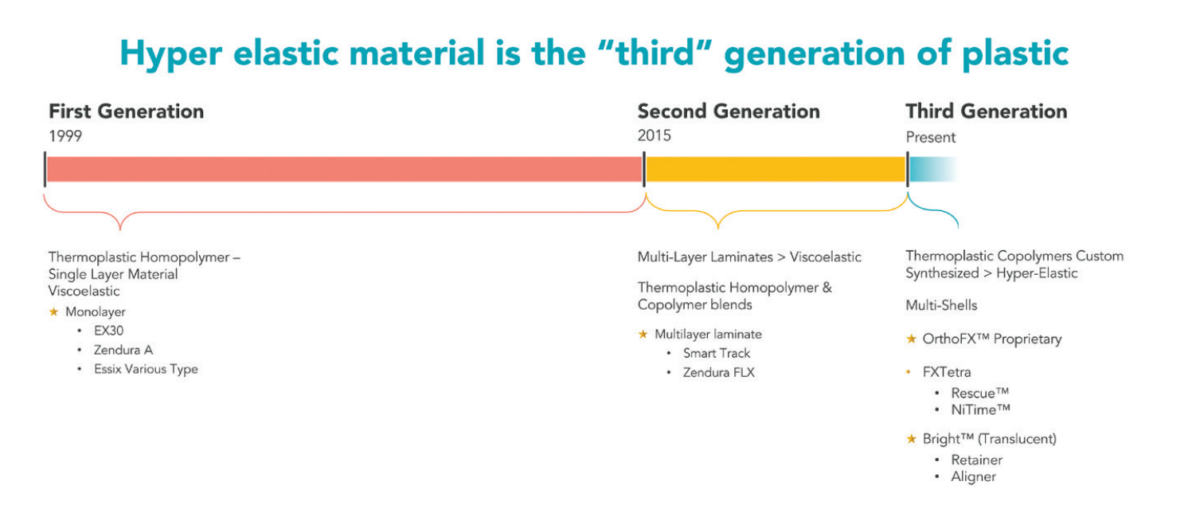
The shared goal of the orthodontic field is to utilize mechanical forces to encourage conventional tooth movement through the biological cascades of resorption and apposition. Thus, the preferred method of practitioners would be a steadily delivered, optimal force throughout the entire duration of treatment. Unfortunately, this is where many thermal plastics fail due to the characteristics of a multi-laminated material. Regardless of tertiary structure, Hooke’s Law is pervasive. The plastic properties of many industry standard aligners resemble the stress/strain curve shown in Figure 2. Note the steepness of the curve initially, as the material quickly reaches the elastic limit point. The key point of interest is the elongation at yield. Once the appliance yields, it is no longer effective as an appliance — instead, it becomes passive. This “fast to load” and “fast to die” behavior is characteristic of viscoelastic materials.

To better understand the difference in material limitations, Figure 3 illustrates actual test data of a standard industry aligner material (Zendura® FLX™) and the OrthoFX hyper-elastic aligner material. The standard aligner material exhibits an elastic limit of approximately 5%, which is about 0.25 mm of strain/tooth movement per stage/aligner. Conversely, the OrthoFX hyper-elastic material is a half order magnitude greater in elasticity (25%), meaning it can deliver 1.25 mm of tooth movement per aligner at maximum elasticity. This allows for the OrthoFX hyper-elastic aligner to provide a wider range of fit in tandem with consistent loads during treatment.
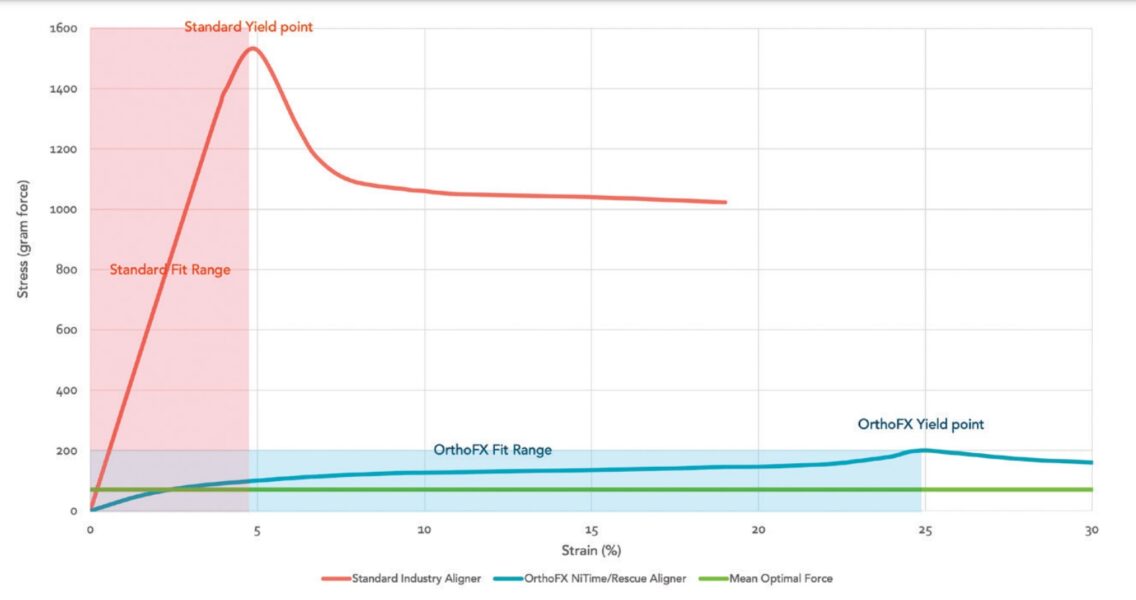
Hyper-elasticity and fit range
The fit of the aligner is the initial, yet crucial, step to providing effective orthodontic treatment to patients. If an aligner fails to fit over the dentition, it will require mid-course corrections and refinements, which can also negatively impact patient satisfaction. To provide a broad range of fit, the hyper-elastic properties of OrthoFX aligners mimic super-elastic wire for fixed appliances (Nitinol wire). This is a critical feature for NiTime aligners, which are not worn for the standard 22 hours so can lead to the occasional dentition shift. In response, the OrthoFX NiTime Aligners offer a broad fit range to accommodate daytime shifts while continuing to move forward with the required tooth movements.
As seen in Figure 3, OrthoFX hyper-elastic aligners provide a fit range that is 5 times greater than the industry standard, while Figure 4 compares the fit ranges between an industry standard aligner (Bay Materials FLX™) and two OrthoFX aligners — NiTime and Rescue (a recovery aligner with similar elasticity to NiTime). The OrthoFX aligners have superior fit ranges by as much as +/- 4 aligner stages for a single aligner as compared to the industry standard aligners with just +/- 1 aligner stage.
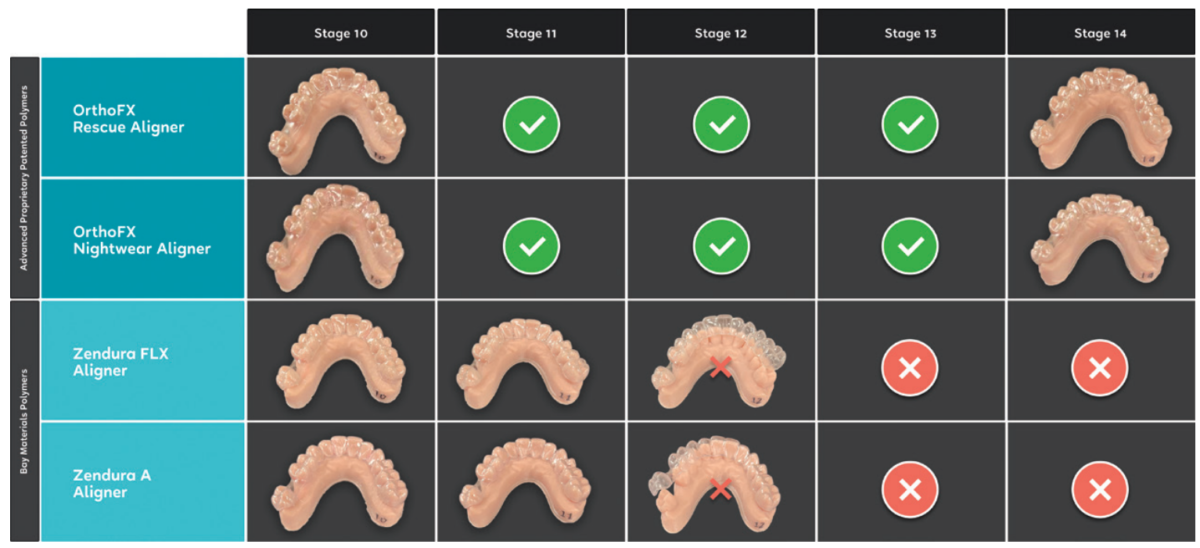
Hyper-elasticity and optimal forces
Once fit has been established, ideal forces are essential for predictable and biologically favored tooth movement. To move teeth safely and efficiently, it is important to use continuous, optimal force until the tooth reaches the desired position. Figure 5 shows the forces available for a standard industry aligner compared to an OrthoFX hyper-elastic aligner. Note the industry standard aligner’s high initial force that quickly drops below the force required for effective tooth movement versus the constant force supplied by a hyper-elastic aligner.
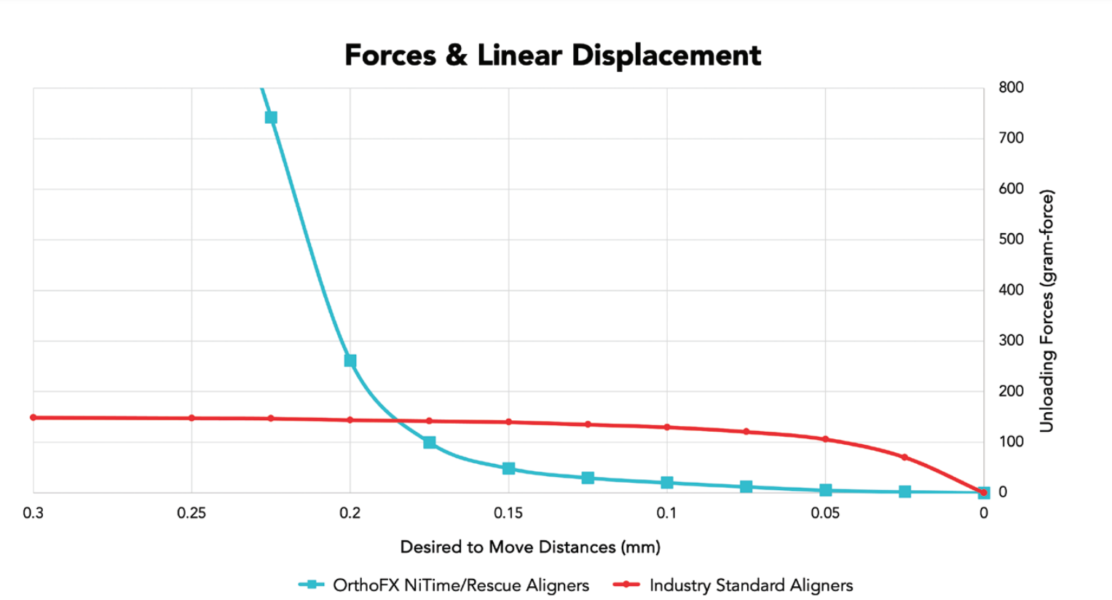
Excessive force over an extended duration can cause root resorption and eventually tooth loss, which is a direct effect of tissue remodeling from inflammation known as “undermining resorption.” Furthermore, this process fails to deliver desired orthodontic tooth movements due to sterile necrosis of the locally required cellular activities. The main area of concern, for the delivery of optimal force and duration is the periodontal ligament.1 Excessive forces are detrimental to the PDL, causing hyalinization of the ligament and Sharpe’s fibers attaching the root to the bone, thereby creating extreme pain for the patient.
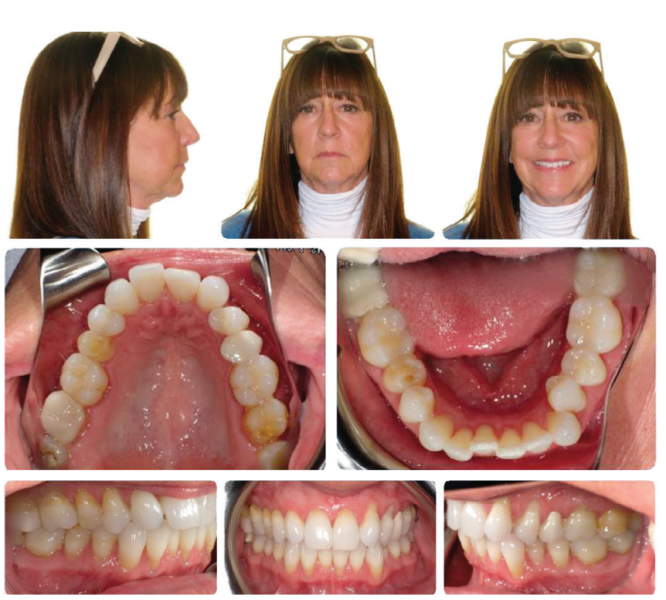
OrthoFX hyper-elastic aligners follow neo-Hookean principles that generate the optimal force required for tooth movement over the entire duration of patient wear, to follow the “frontal resorption” biological process. Over a 7-day cycle of consistent force delivery, NiTime Aligners can achieve higher efficiency with greater patient comfort and a more convenient wear time. In fact, wear time is reduced from the recommended 22 hours per day to 9 to 12 hours contiguously each day, at minimum. This reduction in daily aligner wear does not extend the total treatment duration and can significantly improve patients’ daytime quality of life leading to happier, more satisfied patients. The more satisfied the patient, the more likely they are to consistently follow through in their care.

Figures 6 through 9 demonstrate a patient successfully treated with NiTime Aligners following the patient’s rejection of other systems. Figures 6 and 8 display pre- and posttreatment photos of a patient that presented with a Class II malocclusion and normal OB/OJ. This patient has teeth Nos. 7 and 10 missing congenitally. Note that the patient was treated as a child and has a canine substitution due to the missing lateral incisors. Recession was noted on tooth Nos. 2,3, 4, 5, 9, 11, 13, 14, 22, 24, 26, and 27. The patient tried labial and lingual brackets unsuccessfully, as well as a leading clear aligner to correct her malocclusion as an adult. In all three treatments, the patient could not tolerate the mechanics due to increased discomfort and was unable to complete therapy.
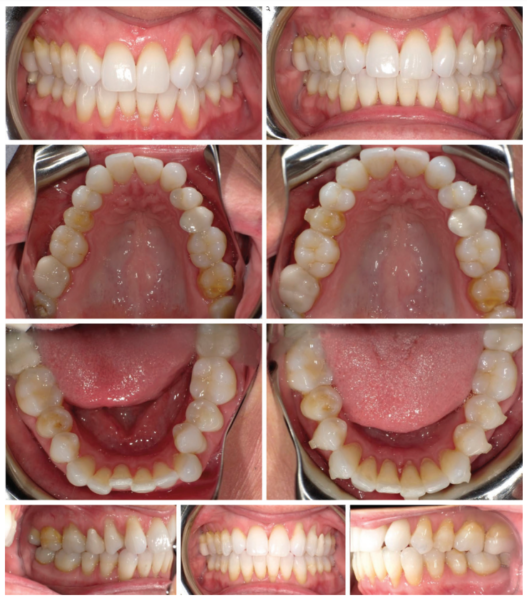
It is important to note that there was no refinement required for this case, and the patient finished in 26 weeks with 26 trays. Although the patient presented with significant recession, it did not worsen with treatment. As demonstrated in Figure 9, teeth aligned as planned by the OrthoFX treatment plan shown in Figure 7. Overlays of the actual results with the original treatment plan indicate a high level of predictive accuracy. Not only was a satisfactory result produced from the patient wearing the aligners, but the accuracy is quite high for the NiTime material despite the patient wearing it significantly less than the traditional 22 hours per day.

Conclusion
To ensure the predictable completion of aligner orthodontic treatment, flexibility in aligner dentition fit and the application of biologically desired forces are imperative. These attributes are unattainable with the industry’s outdated generation of viscoelastic material. The hyper-elastic properties of OrthoFX polymers provide a wide range of fit and optimal forces to deliver results efficiently, while providing patients a higher degree of comfort and convenience.
* Internal data generated by OrthoFX R&D
Whether using NiTime aligners, other aligners, or wires and brackets, monitoring patient progress is essential. Read about how DentalMonitoring can help you monitor, measure, and master patient information. https://orthopracticeus.com/orthodontic-experts/how-to-love-your-practice-life/
- Ren Y, Maltha JC, Kuijpers-Jagtman AM. Optimum force magnitude for orthodontic tooth movement: a systematic literature review. Angle Orthod. 2003 Feb;73(1):86-92.
Stay Relevant With Orthodontic Practice US
Join our email list for CE courses and webinars, articles and mores


